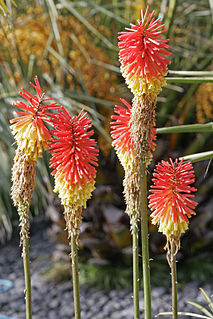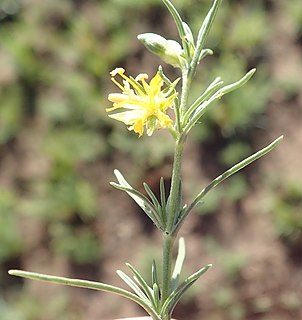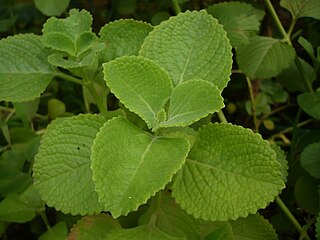
Kniphofia, also called tritoma, red hot poker, torch lily, or poker plant, is a genus of perennial flowering plants in the family Asphodelaceae, first described as a genus in 1794. It is native to Africa.

Cyperus haspan is a dwarf papyrus sedge in the Cyperaceae. It is widely distributed in tropical and subtropical regions in Africa, Madagascar, southern Asia, New Guinea, Australia, South America, West Indies, Central America, southern Mexico and the southeastern United States.

Vahlia is a genus of herbs and subshrubs that grow in Africa and the Indian subcontinent. There are at least five species.
Phaenanthoecium is a genus of plants in the grass family. The only known species is Phaenanthoecium koestlinii, native to Northeast Tropical Africa and Yemen.
Exotheca is a genus of African and Southeast Asian plants in the grass family.
Afrotrichloris is a genus of East African plants in the grass family.
Cleistachne is a genus of African and Asian plants in the grass family. The only known species is Cleistachne sorghoides, native to eastern and southeastern Africa, and parts of Asia.
Lintonia is a genus of African plants in the grass family.
Coelachyrum is a genus of Asian and African plants in the grass family.
Crinipes is a genus of plants in the Poaceae−grass family native to central Africa.
Tetrachaete is a genus of plants in the grass family. The origin of the genus name is Greek, from tetra for "four" and chaite, for "bristle." There is only one known species, Tetrachaete elionuroides, native to Eritrea, Ethiopia, Somalia, Kenya, Tanzania, Yemen, and Oman.
Dignathia is a genus of African and Asian plants in the grass family.
Halopyrum is a genus of Asian and African plants in the grass family. The only known species is Halopyrum mucronatum, native to the Indian Subcontinent, Iran, the Arabian Peninsula, Socotra, Madagascar, and eastern + northeastern Africa.
Lasiurus is a genus of Asian and African plants in the grass family, Poaceae, found primarily in arid regions. The only known species is Lasiurus scindicus, native to drier regions of northern Africa and southwestern Asia, from Morocco and Mali to India.
Leptagrostis is a genus of bunchgrasses in the tribe Molinieae of the grass family, Poaceae, native to eastern Africa.
Ochthochloa is a genus of desert plants in the grass family native to the Sahara and Arabian Deserts. The only known species is Ochthochloa compressa, whose native range extends from Algeria to Uttarakhand.
Vossia is a genus of Asian and African plants in the grass family.

Coleus is a genus of annual or perennial herbs or shrubs, sometimes succulent, sometimes with a fleshy or tuberous rootstock, found in the Old World tropics and subtropics. The relationship among the genera Coleus, Solenostemon and Plectranthus has been confused. Coleus and Solenostemon were sunk into Plectranthus, but recent phylogenetic analysis found Plectranthus to be paraphyletic with respect to other related genera in the subtribe Plectranthinae. The most recent taxonomic treatment of the genus resurrected Coleus, and 212 names were changed from combinations in Plectranthus, Pycnostachys and Anisochilus. Equilabium was segregated from Plectranthus, after phylogenetic studies supported its recognition as a phylogenetically distinct genus.
Otostegia integrifolia, more commonly known as Abyssinian rose, a plant belonging to the family Lamiaceae, is endemic to Ethiopia, in the dry evergreen woodlands of the Bale Mountains, Tigray, Gondar, Wollo and Gojjam regions, North Shewa, Kaffa and Hararghe regions, as well as in the dry and moist agroclimatic zones of the district known as Dega, at altitudes of 1,300—2,800 m. above sea-level. It also grows in Yemen, northwest of Mukalla. In Ethiopia, O. integrifolia is commonly known by its Amharic vernacular of tinjute = ጥንጁት.

Sebsebe Demissew is a Professor of Plant Systematics and Biodiversity at Addis Ababa University and Executive Director of the Gullele Botanic Garden in Addis Ababa, Ethiopia.




